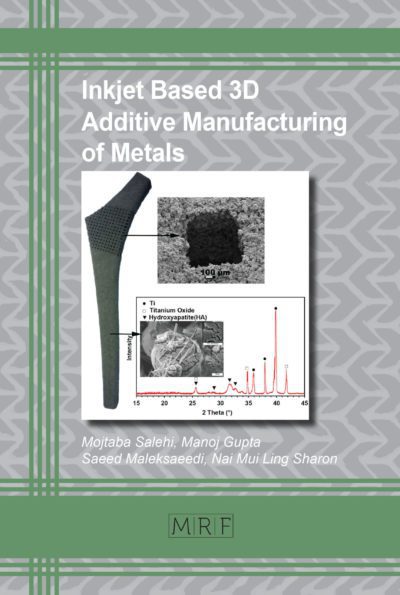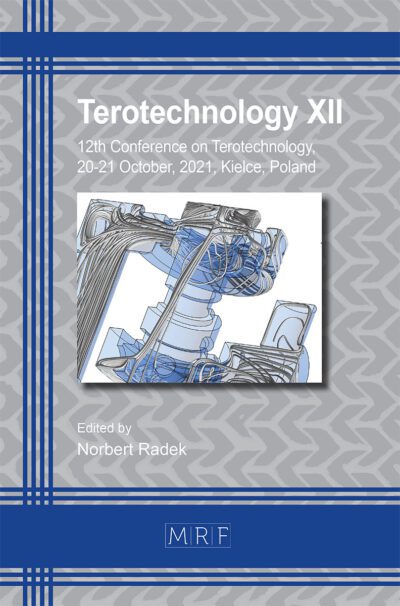Investigating the strength of aluminum and copper parts produced by powder metallurgy using furnace and laser sintering
Muhannad Ahmed Obeidi, Ahmed R. Al-Hamaoy, Pruthviraj Hosuru Venkategowda, Jim White, Dermot Brabazon
Abstract. This study investigates the mechanical properties of copper and aluminum samples produced through powder metallurgy using furnace sintering and laser sintering. The objective is to compare the properties of these samples with those of cast materials and evaluate the effects of varying process parameters on their properties. The samples were tested for punching force determination to evaluate their penetration strength. The results show that copper samples produced through furnace sintering with a 20-minute hold time have properties closest to cast copper and aluminum furnace sintering with a 30- minute hold time produces samples with the highest punching force and deformation value, while laser sintering for both metals is better suited for applications where strength is a more important factor than ductility. The comparison of fracture growth and ductile behavior among different samples produced through cast material, furnace sintering, and laser sintering processes revealed a reduction in deformation from cast materials to furnace sintered materials and a further reduction in laser-sintered samples. The findings of this study can assist in the development of materials with improved mechanical properties for specific applications such as filters, which require porous parts that do not necessarily require the same level of strength as cast materials.
Keywords
Powder Metallurgy, Compaction, Laser Sintering, Punching Strength, Laser Beam
Published online 5/7/2025, 10 pages
Copyright © 2025 by the author(s)
Published under license by Materials Research Forum LLC., Millersville PA, USA
Citation: Muhannad Ahmed Obeidi, Ahmed R. Al-Hamaoy, Pruthviraj Hosuru Venkategowda, Jim White, Dermot Brabazon, Investigating the strength of aluminum and copper parts produced by powder metallurgy using furnace and laser sintering, Materials Research Proceedings, Vol. 54, pp 1616-1625, 2025
DOI: https://doi.org/10.21741/9781644903599-174
The article was published as article 174 of the book Material Forming
![]() Content from this work may be used under the terms of the Creative Commons Attribution 3.0 license. Any further distribution of this work must maintain attribution to the author(s) and the title of the work, journal citation and DOI.
Content from this work may be used under the terms of the Creative Commons Attribution 3.0 license. Any further distribution of this work must maintain attribution to the author(s) and the title of the work, journal citation and DOI.
References
[1] G. Sudha, B. Stalin, M. Ravichandran and M. Balasubramanian, “Mechanical Properties, Characterization and Wear Behavior of Powder Metallurgy Composites – A Review,” Materials Today: Proceedings, vol. 22, no. 4, pp. 2582-2596, 2020. https://doi.org/10.1016/j.matpr.2020.03.389
[2] G. S. Upadhyaya, “Introduction,” in Powder Metallurgy Technology, England, Cambridge International Science Publishing, 2002, pp. 1-3.
[3] A. Simchi, “Direct laser sintering of metal powders: Mechanism, kinetics and microstructural features,” Materials Science and Engineering: A, vol. 428, no. 1-2, pp. 148-158, 2006. https://doi.org/10.1016/j.msea.2006.04.117
[4] P. Angelo and R. Subramanian, “Powder Metallurgy: Basic Steps,” in Powder Metallurgy: Science, Technology and Applications, 4th Edtion ed., Delhi, PHI Learning Private Limited, 2015, pp. 1-18.
[5] M. Y. A. Obeidi, “Laser processing of metallic surfaces for controlled micro-texturing and metallic bonding,” Dublin, 2018.
[6] J. D. Majumdar and I. Manna, “Laser processing of materials,” Sadhana, vol. 28, no. 495-562, 2003. https://doi.org/10.1007/BF02706446
[7] S. Huo, M. Qian, G. Schaffer and E. Crossin, “Aluminium powder metallurgy,” in Fundamentals of Aluminium Metallurgy; Production, Processing and Applications, Woodhead Publishing Limited, 2011, pp. 655-701. https://doi.org/10.1533/9780857090256.3.655
[8] W. S. Yang, J. H. Lee, J. M. Park, D. S. Shin, Y. G. Choi and S. J. Park, “Sintering of Ge-Sb-Se Chalcogenide Glass Powder by Tube Furnace and Spark Plasma Methods,” Journal of Non-Crystalline Solids, vol. 563, p. 120723, 2021. https://doi.org/10.1016/j.jnoncrysol.2021.120723
[9] Z.-q. Tan, U. Engström, K. Li and Y. Liu, “Effect of furnace atmosphere on sintering process of chromium-containing steel via powder metallurgy,” Journal of Iron and Steel Research International, vol. 28, p. 889-900, 2021. https://doi.org/10.1007/s42243-020-00549-z
[10] J. Ranogajec, M. Djuric, M. Radeka and P. Jovanic, “Influence of particle size and furnace atmosphere on the sintering of powder for tiles production,” Ceramics-Silikaty, vol. 44, no. 2, pp. 71-77, 2000.
[11] C.-G. Ha, Y.-G. Jung and U. Paik, “Effect of microstructure on fracture behavior of Al2O3/Al composite by reactive metal penetration,” Journal of Alloys and Compounds, vol. 306, no. 1-2, pp. 292-299, 2000. https://doi.org/10.1016/S0925-8388(00)00782-9
[12] A. M. Sankhla, K. M. Patel, M. A. Makhesana, K. Giasin, D. Y. Pimenov, S. Wojciechowski and N. Khanna, “Effect of mixing method and particle size on hardness and compressive strength of aluminium based metal matrix composite prepared through powder metallurgy route,” Journal of Materials Research and Technology, vol. 18, pp. 282-292, 2022. https://doi.org/10.1016/j.jmrt.2022.02.094
[13] K. Zhang, S. Hamada, K. Shindome, T. Yokoi and H. Noguchi, “Early crack initiation mode during tensile fracture process in a punch-processed precipitation-hardened steel plates and evaluation method to treat the crack as an equivalent pre-crack,” Materials Science and Engineering: A, vol. 850, p. 143534, 2022. https://doi.org/10.1016/j.msea.2022.143534
[14] Y. Kimura, T. Wakabayashi, K. Okada, T. Wada and H. Nishikawa, “Boron nitride as a lubricant additive,” Wear, vol. 232, no. 2, pp. 199-206, 1999. https://doi.org/10.1016/S0043-1648(99)00146-5
[15] K. Rajasekhar, V. S. Babu and M. Davidson, “Microstructural and mechanical properties of Al-Cu functionally graded materials fabricated by powder metallurgy method,” Materials Today: Proceedings, vol. 41, pp. 1156-1159, 2021. https://doi.org/10.1016/j.matpr.2020.09.157
[16] M. A. Obeidi, “Additive Design Mimics the Strength and Architect of Nature,” Journal of Material Science and Technology Research, vol. 10, pp. 1-11, 2023. https://doi.org/10.31875/2410-4701.2023.10.01














